________________
34
OUTLINES OF INDIAN PHILOSOPHY
of a long process of degeneration, as has already been shown. The theism of the Upanishads had separated the highest soul from the individual soul, opposing to them a primordial matter. After the elimination of the highest soul there remained two principles-(1) prakriti, primeval matter, and (2) a plurality of purushas or subjects of knowledge. This dualism, as the starting-point of the Sânkhya system, is in itself quite incomprehensible; it becomes intelligible only by its development as shown before. The aim of man is the emancipation of the purusha from the prakriti, and this is attained by the knowledge that purusha and prakriti are totally different, and that all the pains of life, being only modifications of prakriti, do not affect the purusha in the least. To awaken this consciousness in purusha, prakriti unfolds its essence to it anew in every life, producing by gradual evolution the cosmic intellect (Mahân or Buddhi), from this the principle of individuation (Aharkâra), from this mind, organs of sense, and the rudiments, and from the latter materials objects. The purusha beholds this evolution of prakriti; if he understands that prakriti is different from himself he is emancipated, if not he remains in the circle of transmigration and suffering. The whole system seems to be based on an original assumption that there is only one purusha and one prakriti by the separation of which the final aim is attained for both. The pretended plurality of purushas looks like a later addition; and we do not understand how the one and indivisible prakriti develops its being before every single purusha again and again to help him in his emancipation, if there always remains an innumerable quantity of une
Jain Education International
For Private & Personal Use Only
www.jainelibrary.org




